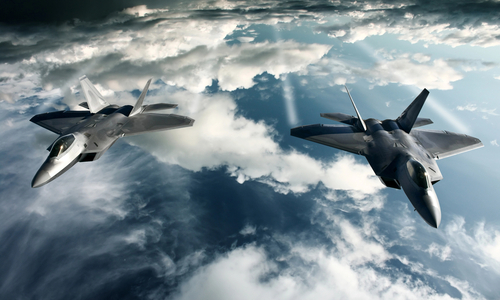
Once the crown jewel of the U.S. Air Force, the F-22 Raptor represented the pinnacle of fifth-generation fighter technology.

Unmatched in air superiority with its formidable blend of stealth, speed, and maneuverability, the Raptor has captivated military technology enthusiasts and aviation aficionados alike since its inception.

However, the iconic fighter jet now faces an uncertain future as the forces of economics, technological evolution, and strategic realignment conspire to draw the curtain on its storied career.

Originating as the Advanced Tactical Fighter program (ATF) in the late 1980s, the development of the F-22 took place amidst the height of the Cold War.

During the apex of the Cold War, the United States displayed a willingness to allocate substantial resources towards defense initiatives. Of notable concern was advancements in aerospace technology, spurred by the Soviet Union’s proficiency in producing formidable aircraft, courtesy of Sukhoi and Mikoyan.

Seeking to surpass conventional standards, the United States launched the ATF program to dramatically push the boundaries, resulting in the creation of the world’s inaugural fifth-generation fighter.

Pilot and engineer Patrick Bindner described the F-22 as a pioneering venture into uncharted territory.

He highlighted that at the time of its development, the aircraft represented cutting-edge technology, likening it to Star Wars hardware compared to existing equipment at both Lockheed Martin and the USAF.

As they navigated this innovative path, the F-22 was crafted with extraordinary levels of sophistication and utilized top-of-the-line engineering and materials. Though it may appear as a conventional airplane, it marked the inception of a true stealth fighter.

One of the most prominent features of the F-22 is its stealth capabilities. Extensive research was dedicated to reducing the F-22’s radar cross-section (RCS) without compromising the aircraft’s speed and agility.

Laura Clery, an author knowledgeable on the subject, also emphasized the aircraft’s stealth capabilities which were achieved “by utilizing advanced composite materials, such as carbon fiber composites,” which played a crucial role in reducing weight, enhancing maneuverability, and improving performance.

Despite its groundbreaking design and technological marvels, the F-22’s production was abruptly curtailed after only 195 units were built.

With the conclusion of the Cold War altering the landscape of defense expenditures, the US Air Force found itself in a phase of sequestration by the 2010s, as the Soviet threat had long dissipated.

The restricted fiscal environment led to the F-22 being adversely impacted. Production ceased, marking a 13-year hiatus without a single F-22 being manufactured, signaling the definitive end of its production line.

The aircraft is slated to be gradually decommissioned from active service, paving the way for the forthcoming Next Generation Air Dominance (NGAD) sixth-generation fighter that is currently under development.
Relevant articles:
– The F-22 Stealth Fighter Has 1 Almost Fatal Flaw It Can’t Fix, The National Interest
– Explained: The Strengths & Weaknesses Of The F-22 Raptor Fighter Jet, simpleflying.com
